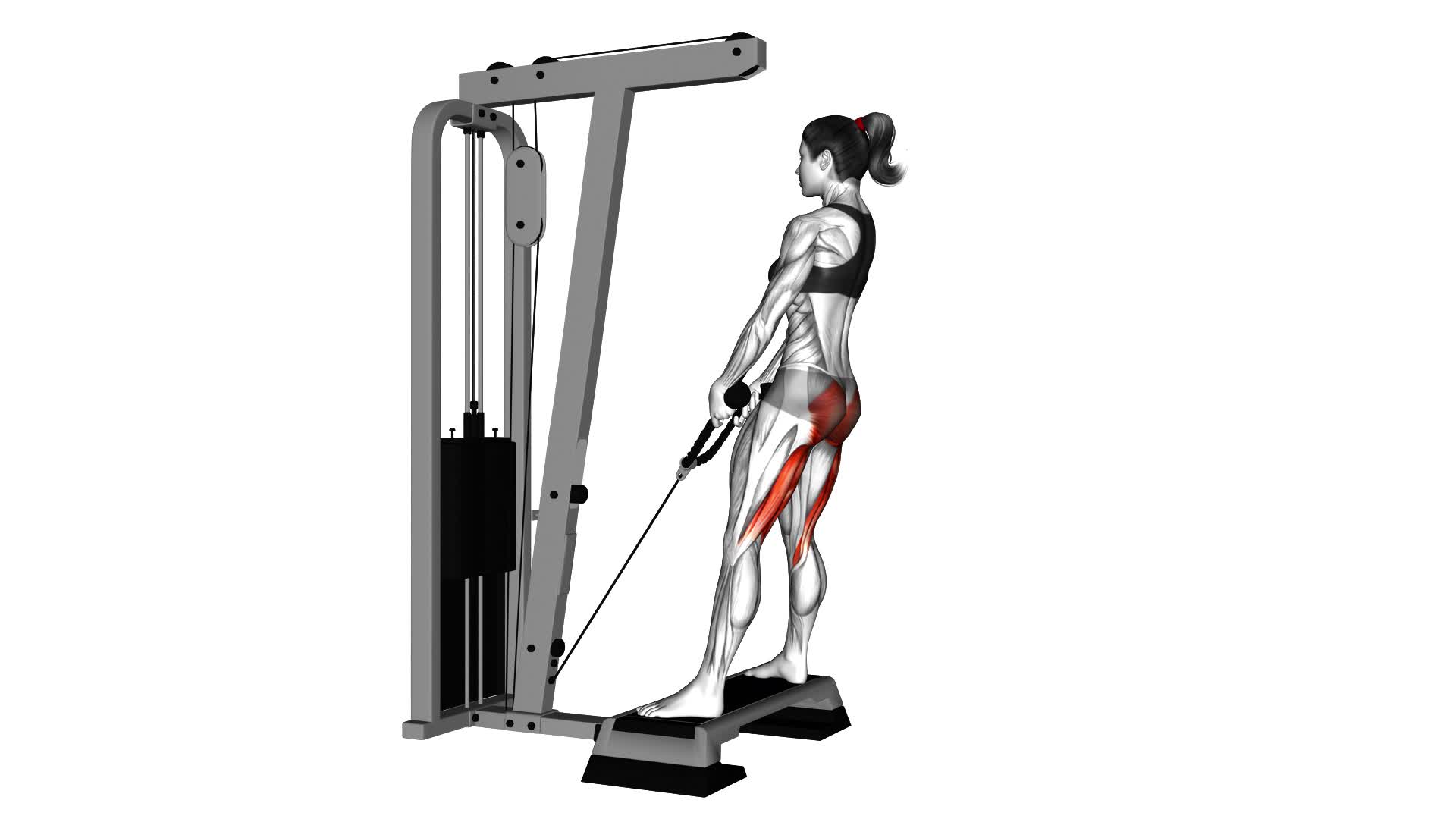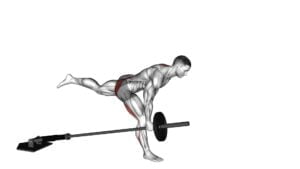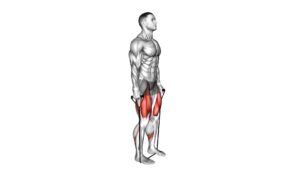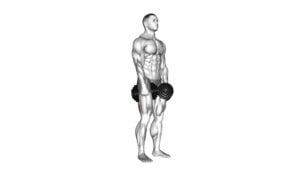Cable Stiff Leg Deadlift From Stepbox (Female) – Video Exercise Guide & Tips

In this video exercise guide, you'll learn how to perform the cable stiff leg deadlift from a stepbox.
Watch This Exercise Video
This exercise is specifically designed for females, targeting the lower body muscles.
You'll discover the benefits of this exercise, the equipment needed, and the proper form and technique.
Plus, we'll cover common mistakes to avoid and provide variations and progressions to challenge yourself.
Get ready to strengthen and tone your legs with this effective workout!
Key Takeaways
- The cable stiff leg deadlift targets and strengthens posterior chain muscles.
- Using a cable machine provides constant tension for increased muscle activation and strength.
- This exercise offers greater control and stability compared to free weights.
- Variations of the cable stiff leg deadlift can target different muscle groups within the posterior chain.
Benefits of the Cable Stiff Leg Deadlift
One benefit of the Cable Stiff Leg Deadlift is that it allows you to effectively target and strengthen your posterior chain muscles.
The cable stiff leg deadlift is a variation of the traditional stiff leg deadlift exercise that utilizes a cable machine instead of a barbell or dumbbells. This variation offers several advantages over the traditional deadlift.
First, using a cable machine provides constant tension throughout the entire range of motion, which can help to increase muscle activation and overall strength.
Second, the cable stiff leg deadlift allows for greater control and stability, as the cable provides a more balanced resistance compared to free weights. This can be especially beneficial for individuals who struggle with maintaining proper form during the exercise.
Lastly, the cable stiff leg deadlift offers a variety of variations that can target different muscle groups within the posterior chain, such as the glutes, hamstrings, and lower back.
Equipment Needed for the Exercise
To perform the Cable Stiff Leg Deadlift From Stepbox (Female) exercise, you'll need specific equipment. This exercise requires a cable machine with a low pulley attachment and a stepbox.
The cable machine should have enough weight plates to challenge your muscles effectively. When choosing the right weight for this exercise, it's important to consider your current fitness level and strength. Start with a weight that allows you to perform the exercise with proper form and control.
As you become more comfortable and stronger, gradually increase the weight to continue challenging your muscles. It's also essential to choose a weight that allows you to complete the desired number of repetitions and sets without compromising your technique.
Proper Form and Technique
Keep your back straight and core engaged throughout the Cable Stiff Leg Deadlift From Stepbox (Female) exercise. Proper form and technique are crucial for maximizing the benefits of this exercise and reducing the risk of injury.
Here are some important tips to keep in mind:
- Common misconceptions
- Avoid rounding your back: One common misconception is that rounding your back during this exercise is acceptable. However, this can put excessive strain on your spine and increase the risk of injury.
- Don't lock your knees: Some people mistakenly believe that locking their knees at the top of the movement is correct. However, this can lead to hyperextension and potential knee injuries. Keep a slight bend in your knees throughout the exercise.
- Key muscles targeted
- Hamstrings: The Cable Stiff Leg Deadlift primarily targets your hamstrings, which are the muscles located at the back of your thighs. Engage these muscles to control the movement and lift the weight.
- Glutes: Your glute muscles, or the muscles in your buttocks, also play a significant role in this exercise. Squeeze your glutes at the top of the movement to maximize their activation.
Common Mistakes to Avoid
To ensure proper form and technique during the Cable Stiff Leg Deadlift From Stepbox (Female) exercise, it's important to be aware of common mistakes to avoid.
One common mistake is improper breathing technique. Remember to inhale as you lower the weight and exhale as you lift it. Proper breathing helps to stabilize your core and enhance your overall performance.
Speaking of core, another mistake to avoid is neglecting its engagement. Your core muscles play a crucial role in maintaining stability and protecting your lower back during this exercise. So, make sure to engage your core by pulling your navel towards your spine throughout the movement. This will help you maintain a strong and stable torso.
By avoiding these common mistakes and focusing on proper breathing technique and core engagement, you can maximize the benefits of the Cable Stiff Leg Deadlift From Stepbox (Female) exercise.
Remember to always prioritize safety and listen to your body.
Variations and Progressions
Try incorporating different variations and progressions of the Cable Stiff Leg Deadlift From Stepbox (Female) exercise to challenge your muscles and continue to improve your strength and stability. Here are some variations and progressions to consider:
- Increase the weight: Gradually increase the weight you're lifting to challenge your muscles and promote muscle growth.
- Single-leg variations: Perform the exercise using only one leg at a time. This will increase the demand on your muscles and improve balance and stability.
- Romanian deadlift: Instead of using the cable machine, perform the exercise with a barbell or dumbbells. This will target your hamstrings and glutes in a slightly different way.
- Elevated platform: Try performing the exercise on an elevated platform, such as a step or box. This will increase the range of motion and further engage your muscles.
- Tempo variations: Experiment with different tempos during the exercise. Slow down the lowering phase to increase time under tension, or try explosive movements for power development.
By incorporating these different exercises and variations, you can target your muscles in new and challenging ways, leading to increased muscle activation and continued progress in strength and stability.
Keep challenging yourself and enjoy the benefits of a stronger and more stable body.
Frequently Asked Questions
How Many Sets and Reps Should I Do for the Cable Stiff Leg Deadlift?
For the cable stiff leg deadlift, the number of sets and reps will depend on your fitness level and goals. It's important to start with a weight that challenges you but allows you to maintain proper form. Generally, you can start with 3 sets of 8-12 reps.
As you progress, you can increase the weight and decrease the reps for a more challenging workout. Remember to consult with a fitness professional to determine the best approach for you.
Can I Do the Cable Stiff Leg Deadlift if I Have Lower Back Pain?
If you're dealing with lower back pain, it's important to be cautious when performing exercises that target that area.
There are various exercises specifically designed to strengthen your lower back, and it's always a good idea to incorporate them into your routine.
However, when it comes to deadlifts, modifications can be made to avoid aggravating your pain.
Consult with a fitness professional to find the best modifications for you and ensure you're performing the exercise correctly and safely.
What Are Some Alternative Exercises That Target the Same Muscles as the Cable Stiff Leg Deadlift?
If you're looking for alternative exercises that target the same muscles as the cable stiff leg deadlift, there are a few options you can try.
One modification is the dumbbell stiff leg deadlift, which involves using dumbbells instead of a cable machine.
Another option is the Romanian deadlift, which is similar but focuses more on the hamstrings.
Lastly, you can also try the glute bridge, which targets the glutes and hamstrings.
These exercises can provide a similar workout without putting strain on your lower back.
How Long Should I Rest Between Sets When Performing the Cable Stiff Leg Deadlift?
When performing the cable stiff leg deadlift, it's important to consider how long you should rest between sets. Rest duration between sets can vary depending on your fitness level and goals. Generally, it's recommended to rest for about 60-90 seconds between sets.
This allows your muscles to recover and replenish energy for the next set. Additionally, taking adequate rest can help prevent fatigue and maintain proper form throughout the exercise, maximizing the benefits of the cable stiff leg deadlift.
Is It Necessary to Use a Stepbox for the Cable Stiff Leg Deadlift, or Can I Perform It on the Floor?
Performing the cable stiff leg deadlift on the floor is an option, but using a stepbox can provide additional benefits.
The stepbox allows for a greater range of motion, making the exercise more challenging and effective in targeting the hamstrings and glutes.
It also helps maintain proper form and alignment throughout the movement.
Conclusion
In conclusion, the cable stiff leg deadlift is an effective exercise for targeting the hamstrings, glutes, and lower back.
By using a stepbox, you can increase the range of motion and challenge your muscles further.
It's important to maintain proper form and technique to avoid injury and maximize results.
By avoiding common mistakes and incorporating variations and progressions, you can continue to progress and improve your strength and stability.

Author
Years ago, the spark of my life’s passion ignited in my mind the moment I stepped into the local gym for the first time. The inaugural bead of perspiration, the initial endeavor, the very first surge of endorphins, and a sense of pride that washed over me post-workout marked the beginning of my deep-seated interest in strength sports, fitness, and sports nutrition. This very curiosity blossomed rapidly into a profound fascination, propelling me to earn a Master’s degree in Physical Education from the Academy of Physical Education in Krakow, followed by a Sports Manager diploma from the Jagiellonian University. My journey of growth led me to gain more specialized qualifications, such as being a certified personal trainer with a focus on sports dietetics, a lifeguard, and an instructor for wellness and corrective gymnastics. Theoretical knowledge paired seamlessly with practical experience, reinforcing my belief that the transformation of individuals under my guidance was also a reflection of my personal growth. This belief holds true even today. Each day, I strive to push the boundaries and explore new realms. These realms gently elevate me to greater heights. The unique combination of passion for my field and the continuous quest for growth fuels my drive to break new ground.







